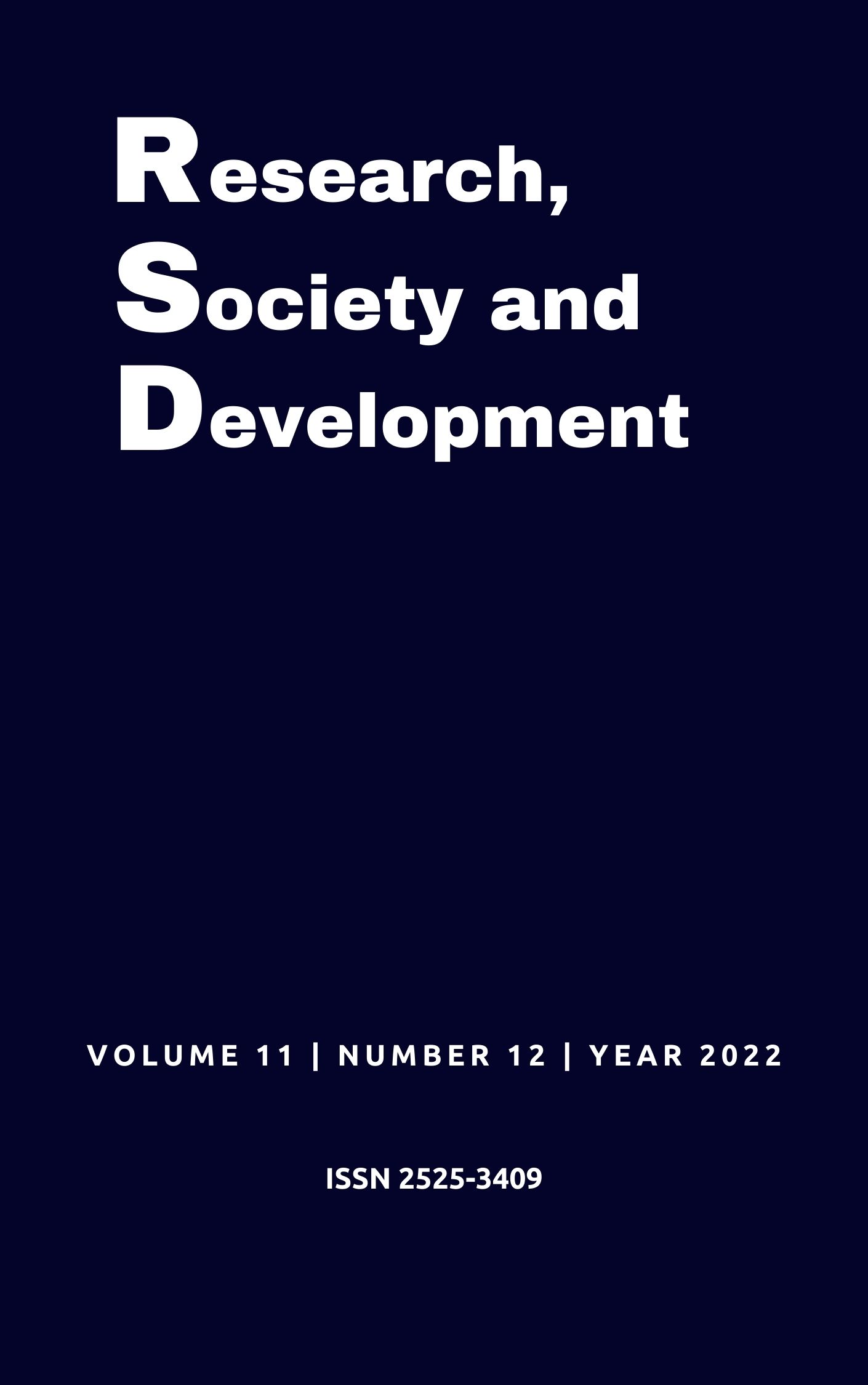Desvalorização da cultura esportiva no ambiente escolar
DOI:
https://doi.org/10.33448/rsd-v11i12.34814Palavras-chave:
Adolescente, Criança, Educação Física, Comportamento Sedentário, Estudantes.Resumo
Os objetivos deste estudo foram analisar e identificar prováveis relações entre comportamento sedentário e inatividade física de crianças e adolescentes discentes com a predominância do conceito de corpo Cartesiano no ambiente escolar e a falta de aprendizado sobre cultura esportiva nas aulas de Educação Física no ensino fundamental. A pesquisa foi por uma abordagem transversal qualitativa com participação de 19 discentes com faixa etária entre 14 a 17 anos, ambos os sexos. O instrumento de coleta de informações – questionário – questão discursiva submetida à técnica adaptada de análise de discurso. Identificou-se que a desvalorização da cultura esportiva que são atividades aparentemente físicas, no ambiente escolar a partir da predominância de concepção Cartesiana de corpo e a ausência do acesso e apropriação da cultura esportiva durante as aulas de Educação Física podem contribuir para o comportamento sedentário e inatividade física de crianças e adolescentes discentes.
Referências
Chaer, G., Diniz, R. R. P., & Ribeiro, E. A. (2011). The questionnaire technique in educational research. Revista Evidência, 7(7), 251–266. Retrieved from http://www.uniaraxa.edu.br/ojs/index.php/evidencia/article/view/201
Craig, C. L., Marshall, A. L., Sjöström, M., Bauman, A. E., Booth, M. L., Ainsworth, B. E., … Oja, P. (2003). International physical activity questionnaire: 12-country reliability and validity. Medicine and Science in Sports and Exercise, 35(8), 1381–1395. https://doi.org/10.1249/01.MSS.0000078924.61453.FB
Ferreira, R. W., Rombaldi, A. J., Ricardo, L. I. C., Hallal, P. C., & Azevedo, M. R. (2016). Prevalence of sedentary behavior and its correlates among primary and secondary school students. Revista Paulista de Pediatria (English Edition), 34(1), 56–63. https://doi.org/10.1016/j.rppede.2015.09.002
Ferreira Silva, R. M., Mendonça, C. R., Azevedo, V. D., Memom, A. R., Noll, P. R. E. S., & Noll, M. (2022). Barriers to high school and university students’ physical activity: A systematic review. PloS One, 1–24. https://doi.org/10.1371/journal.pone.0265913
Guerra, P. H., Barbosa Filho, V. C., Almeida, A., Silva, L. de S., Pinto, M. T. V., Leonel, R. M., … Florindo, A. A. (2020). Systematic review of physical activity and sedentary behavior indicators in south-american preschool children. Revista Paulista de Pediatria, 38. https://doi.org/10.1590/1984-0462/2020/38/2018112
Guthold, R., Stevens, G. A., Riley, L. M., & Bull, F. C. (2019). Global trends in insufficient physical activity among adolescents : a pooled analysis of 298 population-based surveys with 1 · 6 million participants. The Lancet Child and Adolescent Health, 4(1), 23–35. Retrieved from http://dx.doi.org/10.1016/S2352-4642(19)30323-2
Instituto Brasileiro de Geográfia Estatística. (2015). Pesquisa Nacional por Amostra de Domicílios: síntese de indicadores. In Ministério do Planejamento Orçamento e Gestão. Instituto Brasileiro de Geografia e Estatística - IBGE (2a). https://doi.org/http://biblioteca.ibge.gov.br/visualizacao/livros/liv94935.pdf
Mantovani, T. V. L., Maldonado, D. T., & Freire, E. D. S. (2021). A relação entre saúde e educação física escolar: uma revisão integrativa. Movimento (ESEFID/UFRGS), 27, e27008. https://doi.org/10.22456/1982-8918.106792
Mckenzie, T. L., & Lounsbery, M. A. F. (2009). School Physical Education: The Pill Not Taken. American Journal of Lifestyle Medicine, 3(3), 219–225. https://doi.org/10.1177/1559827609331562
Melo, J., Pedretti, A., Gaya, A. R., & Gaya, A. (2021). Associação entre as variáveis individuais e ambientais do contexto escolar com a aptidão cardiorrespiratória de adolescentes. Saúde e Desenvolvimento Humano, 9(1), 1–10. https://doi.org/10.18316/sdh.v9i1.6224
Mendonça, G., Prazeres Filho, A., Barbosa, A. O., & Farias Júnior, J. C. (2018). Padrões de comportamento sedentário em adolescentes de um município da região Nordeste do Brasil. Revista Brasileira de Atividade Física & Saúde, 23, 1–9. https://doi.org/10.12820/rbafs.23e0023
Minayo, M. C. de S. (2007). Pesquisa social: teoria, método e criatividade. In Serviço Social & Realidade (26a, Vol. 17). Petrópolis, RJ: Vozes, 2007.
Moreira, W. W., Scaglia, A. J., & Campos, M. V. S. de. (2017). Corporeity and motricity in sport pedagogy: indispensable knowledge and attitude for elementary school education. MOTRICIDADES: Revista Da Sociedade de Pesquisa Qualitativa Em Motricidade Humana, 1(1), 42–51. https://doi.org/10.29181/2594-6463.2017.v1.n1.p42-51
Sousa, L. M., Indjai, S., & Martins, E. S. (2021). A reflection on the devaluation of the discipline of physical education in the brazilian school. Revista Do PEMO, 3(2), 1–12. https://doi.org/10.47149/pemo.v1i3.3580
Tassitano, R. M., Bezerra, J., Tenório, M. C. M., Colares, V., de Barros, M. V. G., Hallal, P. C., … Hallal, P. C. (2007). Atividade física em adolescentes brasileiros: Uma revisão sistemática. Revista Brasileira de Cineantropometria e Desempenho Humano, 9(1), 55–60. https://periodicos.ufsc.br/index.php/rbcdh/article/view/4033
Tremblay, M. S., Aubert, S., Barnes, J. D., Saunders, T. J., Carson, V., Latimer-Cheung, A. E., … Chinapaw, M. J. M. (2017). Sedentary Behavior Research Network (SBRN) - Terminology Consensus Project process and outcome. The International Journal of Behavioral Nutrition and Physical Activity, 14(1), 75. https://doi.org/10.1186/s12966-017-0525-8
Downloads
Publicado
Edição
Seção
Licença
Copyright (c) 2022 Rudson Jesus Pereira; Regina Márcia Ferreira Silva; Joana Gabriela Santos Assunção; Marciana Gonçalves Farinha

Este trabalho está licenciado sob uma licença Creative Commons Attribution 4.0 International License.
Autores que publicam nesta revista concordam com os seguintes termos:
1) Autores mantém os direitos autorais e concedem à revista o direito de primeira publicação, com o trabalho simultaneamente licenciado sob a Licença Creative Commons Attribution que permite o compartilhamento do trabalho com reconhecimento da autoria e publicação inicial nesta revista.
2) Autores têm autorização para assumir contratos adicionais separadamente, para distribuição não-exclusiva da versão do trabalho publicada nesta revista (ex.: publicar em repositório institucional ou como capítulo de livro), com reconhecimento de autoria e publicação inicial nesta revista.
3) Autores têm permissão e são estimulados a publicar e distribuir seu trabalho online (ex.: em repositórios institucionais ou na sua página pessoal) a qualquer ponto antes ou durante o processo editorial, já que isso pode gerar alterações produtivas, bem como aumentar o impacto e a citação do trabalho publicado.


